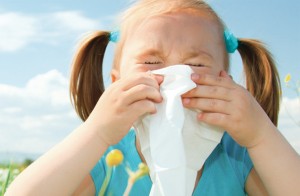By Kevin P Rosenbach, MD – CareOne Healthcare –


Allergic rhinitis and asthma both cause a significant amount of missed school days and reduced ability to learn when at school. Symptoms of asthma and allergies can worsen during school, in both children and teachers, as a result of exposure to indoor allergens in the classroom. Allergens present in carpeting, dust, pillows, stuffed toys, and in upholstered furniture can worsen allergies and asthma.
Here are 5 common allergy triggers to which your child may be exposed to while at school, and some tips for managing the risk your child has an allergic reaction.
Food Allergies
Food allergies are a growing public health issue that impacts almost every school across the United States. Nearly 6 million children in the U.S. – which equates to 1 in 13, or roughly 2 in every classroom – have a food allergy. The most common foods seem to be peanuts, tree nuts, wheat, eggs, cow’s milk, fish, shellfish, and soybeans.
Every child with food allergies should have a complete action plan in place at school in the event of accidentally eating the food to which they are allergic. Talk with an allergy specialist about developing a plan for the school your child attends. In addition, careful planning with the teacher, school nurse and cafeteria staff is needed to ensure that the trigger food is avoided.
Dog and Cat Allergens
Believe it or not, there is a significant amount of dog and cat allergen present in areas where there has never been a dog or cat, especially at schools. Carpeting and upholstered furniture has the highest levels of pet allergens, enough to cause allergy and asthma symptoms in children who are allergic. Dog and cat allergens are carried on the clothing and hair of children who have these pets at home – and the more children in the classroom that are pet owners, the higher the level of pet allergen that can be found within the classroom. If you child is allergic to pet dander, be sure to inform the teacher so that extra steps can be taken to minimize the amount of dander that remains in the classroom.
Dust Mite Allergens
Dust mite allergens do not appear to be present in any significant level in schools, and actually may be slightly lower than in levels found in homes. When found in schools, carpets, upholstered furniture, as well as stuffed animals seem to have the highest levels of dust mite allergen. Because dust mite is a large, heavy particle, it isn’t typically airborne in the classroom, except when there is a lot of physical activity, when it can be found in high levels in the air, enough so that children with dust mite allergy can have worsening symptoms. If you child has a known allergy to dust mites, create a plan with the teacher in which the classroom is regularly cleaned minimizing the accumulated dust in the classroom.
Cockroach and Rodent Allergens
Generally speaking, cockroach and rodent allergens are only found in school classrooms in areas that serve low-income and inner-city areas, as well as rural areas. The highest levels of cockroach and rodent allergens are found where food is kept and served, such as the cafeteria and kitchens. Higher levels are found in non-carpeted areas, as well as in the air. Children with allergies to cockroach and rodent allergens may certainly have worsening asthma and allergy symptoms at school.
Mold Allergens
Mold allergens can be present in schools and classrooms, and is often airborne. The mold in classrooms can be due to outdoor sources or indoor contamination from water damage, standing water, or indoor houseplants. The presence of mold in schools can certainly worsen allergies and asthma in susceptible children.
For kids with allergies, going back to school can mean a return to dealing with allergy issues each day without your direct supervision.
Even if your child is symptom-free at present, having him or her checked out by an asthma and allergy specialist prior to each school year can identify minor problems before they become major. It’s also an opportunity to evaluate medications and physical activity restrictions.
During the annual appointment, is a great time to develop a plan to treat your child’s asthma and allergies if a reaction occurs during school hours.
This may include a meeting with your child’s teacher, school nurse, cafeteria staff and school principal. The meeting should cover your child’s medical problems, need for medications, and special instructions (such as dietary limitations in the case of food allergy). Discuss how to minimize contact with triggers in the classroom and all around school.
Make sure your child’s prescriptions are filled and that you have a written plan to provide to the school nurse and teachers that specifies how medicine is to be used during school hours.
Start this school year with more confidence in your child’s safety at school. Schedule an appointment with an asthma and allergy specialist for a checkup and help creating a plan to give to school administration. With the right precautions, your child can relax and have fun at school, and not have to worry about having an allergic reaction.
Kevin P. Rosenbach, MD
CareOne Healthcare
15495 Tamiami Trail North, Suite 119
Naples, FL 34110-6210
(239) 596-5560
 Southwest Florida's Health and Wellness Magazine Health and Wellness Articles
Southwest Florida's Health and Wellness Magazine Health and Wellness Articles

